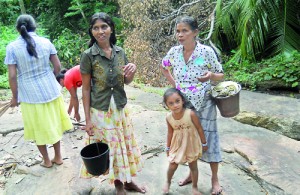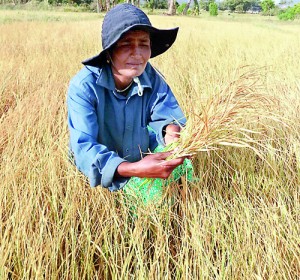News
Despair reigns in drought-stricken areas
Schoolchildren walking in the scorching sun, men and women carrying cans and pots trudging long distances searching for drinking water, farmers crying over lost crop, scrawny cattle desperately looking for green patches—these are common sights in the drought-stricken remote villages in the districts of Hambantota, Anuradhapura, Polonnaruwa, Moneragala, Puttalam, Trincomalee, Kurunegala and Matale.
J. Peetin, a 57 year-old farmer from Lunugamvehera in Hambantota has suffered a bad harvest in both the Maha and Yala seasons. In addition he is burdened by the increasing interest from the loan he took from a mudalali in the area.
“I don’t know how I will be able to pay back the loan. This drought has caused a lot of hardship to paddy farmers. Hundreds of acres of paddyland are now parched lands,” he lamented.
Kirihami (63) from Walasmulla area said this was one of the worst droughts she had experienced in recent years.
“People don’t have rice to eat. And in addition there’s a severe shortage of water. Children in these areas are suffering,” she said.
The Government Agents (District Secretaries) in the drought-stricken areas face the uphill task of coordinating with state institutions to assist the affected people.
Puttalam GA, Kingsley Fernando said eight AG divisions including Wanathawilluwa, Puttalam, Nawagaththegama, Karuwalagaswewa, Mundalama and Anamaduwa have been hard hit with over 5,700 families affected.

Walasmulla: Villagers in search of water. Pic by W. A. Nelka
“There is a severe shortage of water and providing water for drinking purposes and cultivation is difficult. About six tanks that supply water for paddy cultivation have dried up,” he said, adding that the Disaster Management Ministry was assisting in providing drinking water to families.
In Moneragala district, one of the severely affected districts, about 8,000 families have been affected by the drought that prevailed from the beginning of this year, GA of Moneragala A. Pathiananthan said.
In the divisions of Thanamalvila, Buttala, Moneragala, Siyambalanduwa and Wellawaya in Moneragala about 250 hectares of paddy land have turned into parched lands, with the minor tanks supporting them drying up.
“The Water Board is supplying water in bowsers and 100 plastic tanks have been set up with the support of Disaster Management Ministry,” Mr. Pathiananthan said.
He said dry rations were being distributed to affected families through the World Food Programme while a cash-for-work programme that paid R.6, 000 to each person was underway.

Bambaragaswewa: Dried up paddy fields. Pic by Kanchana Kumara Ariyadasa
Polonnaruwa GA, Nimal Abeysiri said that about 15,000 families have been hit by the dry weather conditions in Dimbulagala, Lankapura, Medirigiriya, Welikanda, Hingurakgoda and Elahera areas. In addition he said over 80,000 acres of cultivated land had been affected by the dry weather. Drinking water was being supplied through bowsers.
Eastern Province Agriculture Department director H.M. Hussein said in Trincomalee the Yala cultivation was limited to only 9304 hectares this year compared to 23,561 last year.
He said 430 hectares of cultivated paddlyland had been affected by the drought and maize, ground nut, cowpea, green gram and red onion were being promoted as alternate crops.
North Central Province Agriculture Department director Lakshman Premanath said of the 33,127 hectares of paddyland, only 14,861 hectares were cultivated this Yala season in the districts of Anuradhapura and Polonnaruwa due to the severe shortage of water both in tanks and rivers that feed the crops.
Meanwhile Irrigation Director General, Bhadra Kamaladasa said the water levels in the reservoirs were at a critical stage with just 20 percent remaining. She said the expected rain in October to December was the only hope to improve the fast receding water levels.
Agriculture Department’s Chief Climatologist, Dr. Ranjith Punyawardena said the below normal rains from the monsoons, less carryover water in tanks and reservoirs along with a failed Maha season were some of the reasons for the failure of the present Yala crop. “Paddy consumes a lot of water, therefore it is advisable to go for other crops such as big onion, maize, soyabean and chillie,” he said.
He said the government should give priority to renovate tanks and build more tanks that can store water.
“At present of the major and minor 10,000 tanks only 7,000-8,000 function. The country ideally needs about 20,000 to avoid the problems that arise in drought situations,” he added.
Additional reporting and pictures by Nelka ( Hambantota) and Kanchana Kumara Ariyadasa (Dambulla)

